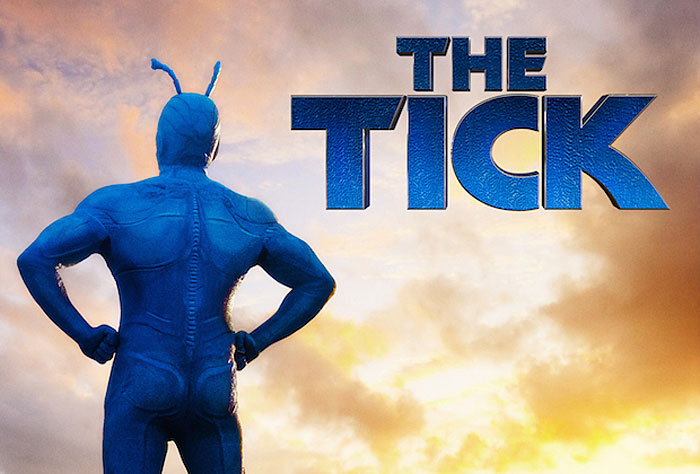In 1994, I was about to be a freshman in high school. Despite being “too old” for cartoons, there wasn’t really anything else on television on Saturday mornings while I was waiting for wrestling to show up on my television screen. I remember most of the cartoons I saw only in the vaguest terms: the creepy face of Louie Anderson’s gargoyle animated child or a screaming purple cat. I know the name of both shows because I looked them up prior to writing this article, but I couldn’t tell you anything about them. However, one show I watched regularly in the mid to late 90s stuck with me well into adulthood, and that’s the 1994-96 animated version of The Tick.
Some of the things said in The Tick have stuck with me for my entire adult life. “Spoon!” and “Not in the face!” were my macro battle cries in World of Warcraft. I have vivid memories of Chairface Chippendale—a supervillain with a chair for a head for some reason—and Sarcarstro (sarcastic Castro, obviously). Die Fledermaus made me research the actual German opera. Sewer Urchin and American Maid were just amusing. But at the centrepiece of the whole thing were The Tick and Arthur.
The Tick’s origin story is befitting any superhero. He’s changed various times according to the media telling the story, but the fictional backstory of the character isn’t quite as interesting as the actual backdrop to the character’s creation.
In 1986, 18-year-old Ben Edlund created a mascot for a Massachusetts comic book store chain called New England Comics. The Tick, then in black and white, started out as just a character for a newsletter, but over time, small stories began to feature The Tick, growing to three-page spreads and, eventually, a stand-alone black-and-white comic book paid for by New England Comics. The Tick proved so successful that the initial Tick stories were reprinted nine times in the decade following the character’s debut, each time with new material added to the story. While attending MassArt, Edlund created a whole other litany of strange characters with names like Paul the Samurai, Chainsaw Vigilante, Man-Eating Cow, and of course, Arthur, the flying accountant who made his debut in Tick #4.
Not bad for a character that started his comic book life as an escaped mental patient whose main powers are optimism, child-like enthusiasm, gigantic size, and nigh-indestructability. The Tick was comic books turned surreal, with the lead character spouting incomprehensible “speeches” and besting “supervillains” with the help of “super friends” who were all dumbed-down parodies of existing superhero properties with more adult humour and situations than your standard DC or Marvel cape. It was weird, and it was popular.
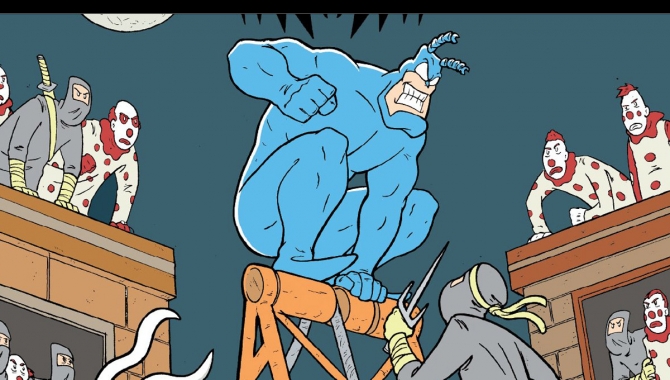
The Tick and his low-rent friends were turned into an animated television show in 1994 by Fox. A similar independent comic book that satirised comic books had been turned in to a wildly successful cartoon series and toy line not too long before. Perhaps you’re familiar with the Teenage Mutant Ninja Turtles? Inspired by the Turtles, Sunbow Entertainment paired Edlund with a writer to crank out a pilot script that Fox promptly rejected. Edlund and Richard Liebmann-Smith (assigned to the project by Sunbow) rewrote the pilot in five sleepless days and got their show picked up. Joining the writing staff at that time was Christopher McCullough, who had worked on Tick comic scripts with Edlund and who would later go on to become one of the creators of the masterful 60s adventure cartoon pastiche The Venture Brothers (another favorite of mine).
From this five-day wonder of a script would come the first season of The Tick, which was a critical success but never quite spawned the toy line Fox and Sunbow were dreaming about. Still, The Tick lasted three seasons on Fox, and was picked up in syndication by Comedy Central, which helped the show find an older audience than Saturday mornings typically offered. The Tick’s voice cast was a who’s-who of cartoon voices, which no doubt helped the show find its feet. The Tick was voiced by the legendary Townsend Coleman (Michelangelo from the Ninja Turtles), with Rob Paulsen (Raphael in the original TNMT, Donatello in the current series) taking over from Mickey Dolenz as Arthur in the second season. Cam Clarke (Leonardo) features as Tick ally Die Fledermaus. Jess “Wakko Warner” Harnell was Sewer Urchin and personal favourite Human Bullet (whose power basically involves loading himself into a cannon and firing himself at The City blindly), and Kay Lenz played American Maid. Filling out the rogue’s gallery are legends like Charlie “Buster Bunny” Adler, Jeff “Johnny Bravo” Bennett, Pat Fraley (59 different TMNT characters alone), Jennifer Hale, Brad Garrett, Dorian Harewood, Zander Berkeley, Dan Castellaneta, Mark Hamill, Tony Jay, Maurice LaMarche (as the incredible The Evil Midnight Bomber What Bombs At Midnight), Bobcat Goldthwait, Tress MacNeille, Roddy McDowall, Laraine Newman, Pat Musick, Kevin Michael Richardson, and Mark Hamill.
A loaded voice cast like that would no doubt help any show continue on long past its cancellation date, and after the success of The Tick in syndication, Fox had the idea to bring the show back as a live-action sitcom with an equally star-studded cast. 2001’s live-action The Tick featured Patrick Warburton—as good a live-action Tick as you could get in 2001—in the big blue suit and David Burke donning the bunny/moth outfit as Arthur. Rounding out the featured players were Liz Vassey as Liberty Maid and the brilliant Nestor Carbonell as Batmanuel. American Maid and Die Fledermaus were owned by Disney were unavailable due to licensing issues, to Ben Edlund took his parodies of Wonder Woman and Batman and made parodies of those parodies.
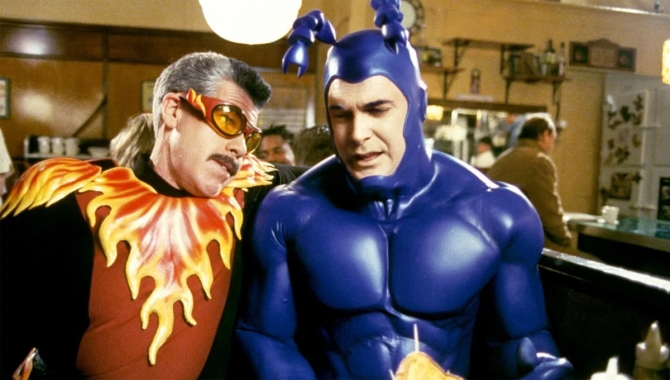
The show restored a lot of the comic book’s more adult humour, and essentially eliminated action scenes to try for a more sitcom vibe. Going for it were strong backers in director Barry Sonnenfeld (riding high after Men In Black) and producer Larry Charles, fresh off Seinfeld and Mad About You. You’d think backing like that would mean Fox would open the purse for The Tick, but alas, that was not the case. After all, this is Fox we’re talking about, who have a checkered history where their more interesting properties are concerned. Even with The Tick being a costumed sitcom, it was still a little too much for Fox to feel comfortable with.
The Tick suffered budget problems almost immediately, as months would pass between the filming of individual episodes due to a lack of funding from the parent network. Fox didn’t own the show, and as such, didn’t really put a lot of promotional muscle behind it. Fearing a writers’ strike and bolstered by the show’s initial success, The Tick was put in competition with two TV juggernauts, NBC’s Must-See TV lineup that Charles helped create and the immortal reality TV juggernaut Survivor. Eight of the nine episodes aired, and The Tick was put out to pasture by Fox. The show remained a cult favourite, and DVD sales did well, but following the live-action death of the big blue bug, the property went into stasis. The popular critical opinion at the time was that the show was simply too good to last. Cast and crew all look back fondly on it, with Patrick Warburton having taken one of the Tick suits from the production, Nestor Carbonell calling it one of his favourite projects, and Barry Sonnenfeld calling the Tick’s pilot the best thing he’s ever directed.
A good property will never go away. Ben Edlund kept busy working on shows like Angel and Firefly with occasional collaborator Joss Whedon and The Venture Brothers with McCullough and Doc Hammer, but The Tick has stayed in the public consciousness for three decades because as super hero movies get bigger and more explosive, there’s a market for someone to show up and have a little fun with the concept again. The 80s were the decade of Superman, the early 2000s were the turf of Batman, and in the Marvel world we live in, why not bring The Tick back once again? This time, Amazon has picked up the cult series (no doubt spurred by Tick DVD sales throughout the years) and is giving The Tick another shot at critical and commercial success.
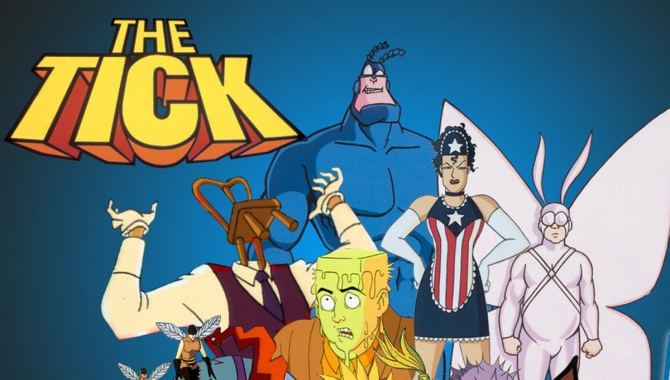
Admittedly, the third go-round at telling the story of The Tick leans heavily on familiar names and faces behind the scenes. Patrick Warburton isn’t in the suit, but he is a producer along with current Tick Peter Serafinowicz. Executive producers of the 2001 Tick, Barry Josephson and Barry Sonnenfeld, are back behind the scenes of this Tick in the same role. Unsurprisingly, Ben Edlund has had a great deal of contribution to the show, both as a producer and as a writer. Even Colleen Atwood, four-time Oscar-winning costume designer, is back to do the show’s updated version of The Tick’s blue super suit/body, but most of the elements in front of the camera have been refreshed.
Arthur (Griffin Newman) is traditionally depicted as a sort of rabbit/moth hybrid to much comic confusion, looks a little bit less like a pair of coveralls with bunny ears. It looks familiar—you can tell it’s Arthur—but the ears have been replaced by feathers and look much more moth-like; Arthur’s suit also looks significantly more like tactical material. The Tick still has moving antennae, but his outfit is a little less shiny blue plastic this time around, going for something that looks a little more protective, like plate armour, rather than vanity molding ab muscles or the more organic look of the pilot episode. Side characters are an interesting assortment of looks and feels. Some, like Overkill (Scott Speiser), would fit into the dark-and-gritty DC universe. Others, like Ramses (Michael Cerveris) and the Eye Of Horus gang, would be at home on the Adam West Batman series. Ms. Lint (Yara Martinez) and Arthur’s sister Dot (Valorie Curry) fall somewhere in Marvel Cinematic Universe territory. Dangerboat (Alan Tudyk) is pure 80s cheese (and perhaps a bonus Simpsons reference).
Arthur’s change isn’t simply in costume, but in character. He’s still an accountant, but he’s also now the main character of the show. The Tick is obviously highly involved, but the first six episodes lean more on Arthur’s life and his slow introduction into the world of being an official AEGIS-registered superhero rather than just a traumatised conspiracy theorist who alternates between boring office job and newspaper-and-string amateur investigator. In that way, he’s a solid introduction into a new world, filling in the back-story of The Terror (a brilliant Jackie Earle Haley) and giving The Tick a world-class straight-man to bounce his big heroic speeches and amusingly off-beat comments against.
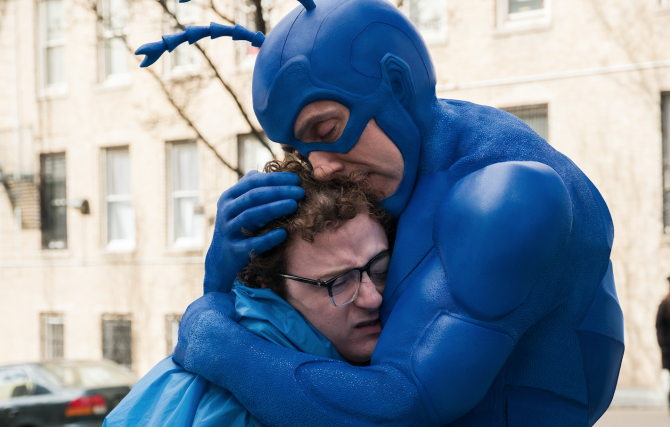
Amazon’s The Tick, at its core, remains what Ben Edlund envisioned 21 years ago. It’s a satire of superhero stories. As such, every superhero iteration finds itself poked, gently or not, by the writing staff (which has a ton of Joss Whedon connections). The way a character looks tends to influence how they’re played and what they’re satirising. It seems nothing avoids mockery, right down to the fact that the mob doctor’s assistant Dot is recognised by the very thugs menacing her when she’s around Arthur. Dangerboat and Overkill have a very Odd Couple relationship, assuming Felix lived inside Oscar and Oscar was a talking crime-fighting boat. The episodes are rich with one-liners and witty visual jokes; I can’t think of a single episode that I saw that didn’t make me laugh out loud at least once, and I watched them by myself with headphones on.
In the episodes previewed, the character relationships drove a lot of the humour, as should be the case. The 2001 show and the cartoon both made a lot of hay out of suits in domestic situations, and this show is no exception. The relationship between The Tick and Arthur is really funny, and pleasantly warm, with Tick actively trying to bolster Arthur’s fragile ego. Arthur and Dot have a solid family relationship; she’s the sister taking care of her brother, until it’s time for the brother to take care of his sister. Ms. Lint’s relationships with The Terror and her scenes with her ex-husband (who she lives with in a shared apartment) are also a surprising amount of fun. Seeing domestic drama between a supervillain with electricity powers and a guy in a tie-dyed shirt rocking out to 311 is just really odd in a clever sort of way, as is the mentor/mentee relationship established between Ms. Lint and The Terror.
Arthur might be the show’s lead character, but The Tick is still The Tick, and he’s still the show’s heart and soul. Peter Serafinowicz is brilliant in the role. Not as bulky as Patrick Warburton, but he’s tall and looks great in the suit. More importantly, he’s able to sell The Tick’s unique combination of child-like wonder and bluster without it feeling overly silly. The Tick believes his nonsense wholeheartedly, and Serafinowicz sells that easily thanks to his expressive eyes and his skill as a voice-over artist filling in the gaps where facial expressions are limited thanks to his mask.
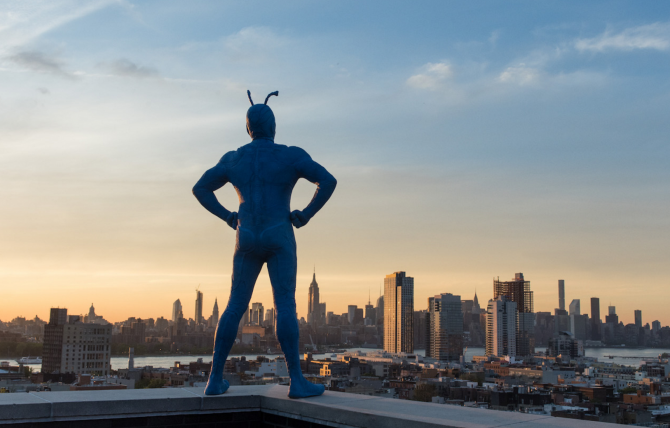
Even when The Tick isn’t the focus in a scene, he’s a joy to watch because he’s always got something going on without trying to steal focus away from the foreground. He’s just a really fascinating character and naturally captivating; once upon a time, Ben Edlund changed The Tick’s costume to blue rather than brown because it looked better in print, and this holds true on film. He’s the most super of the introduced superheroes, save faux-Superman Superian (Brendan Hines), with the grin to match his strength.
One of The Tick’s favorite utterances, when confronted by some bit of science that he doesn’t understand, is “Neat.” The Tick, chums, is neat. Whether it’s going for something small or something big and broad, The Tick packs a comedy punch almost as strong as the titular character. The Tick is great in doses small or big, and there’s enough compelling characters around him to keep the show fresh and interesting through the first six episodes without it being a one-man operation. I have no doubt that the back half, and hopefully future seasons, will be just as good.
The Tick is available now to stream on Amazon Prime Video.

